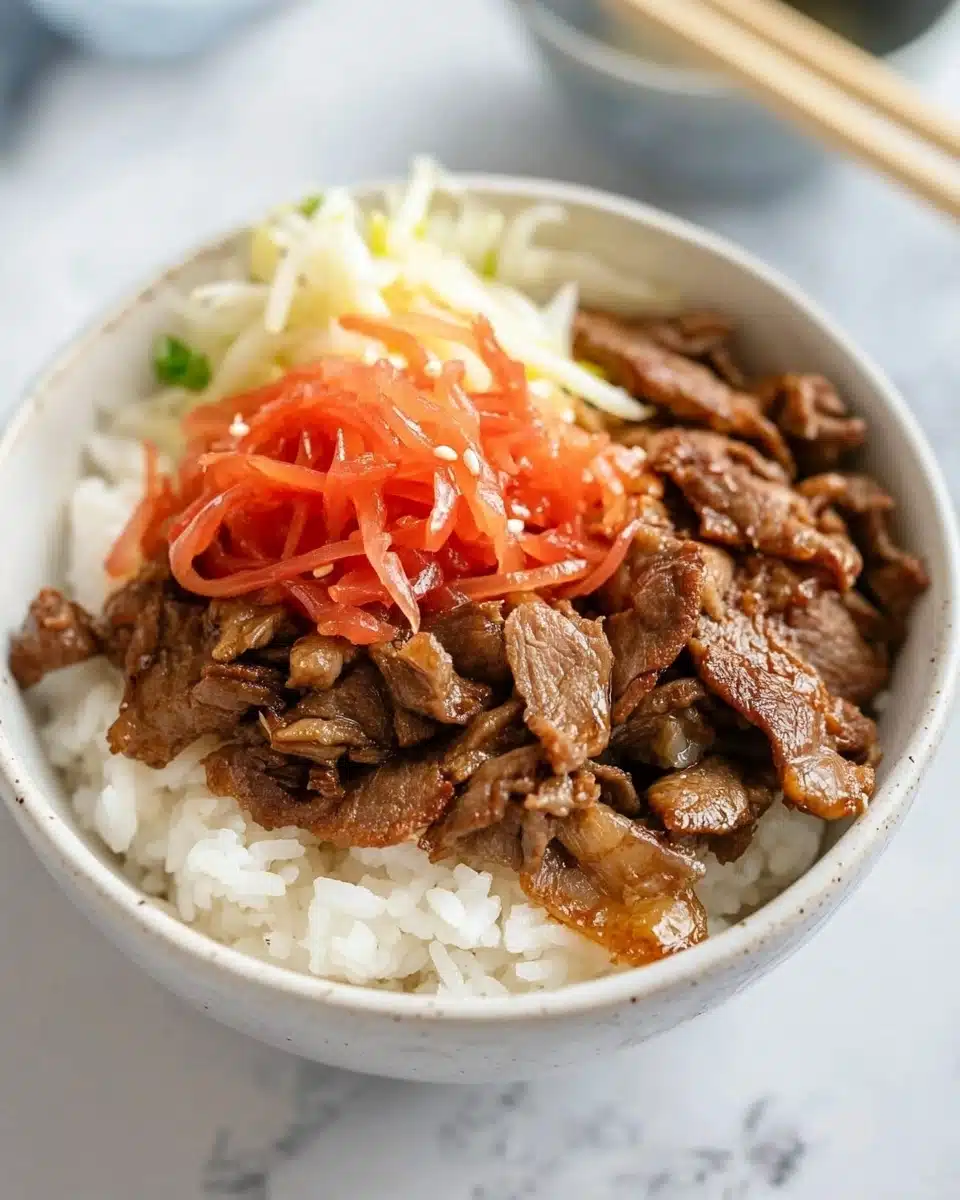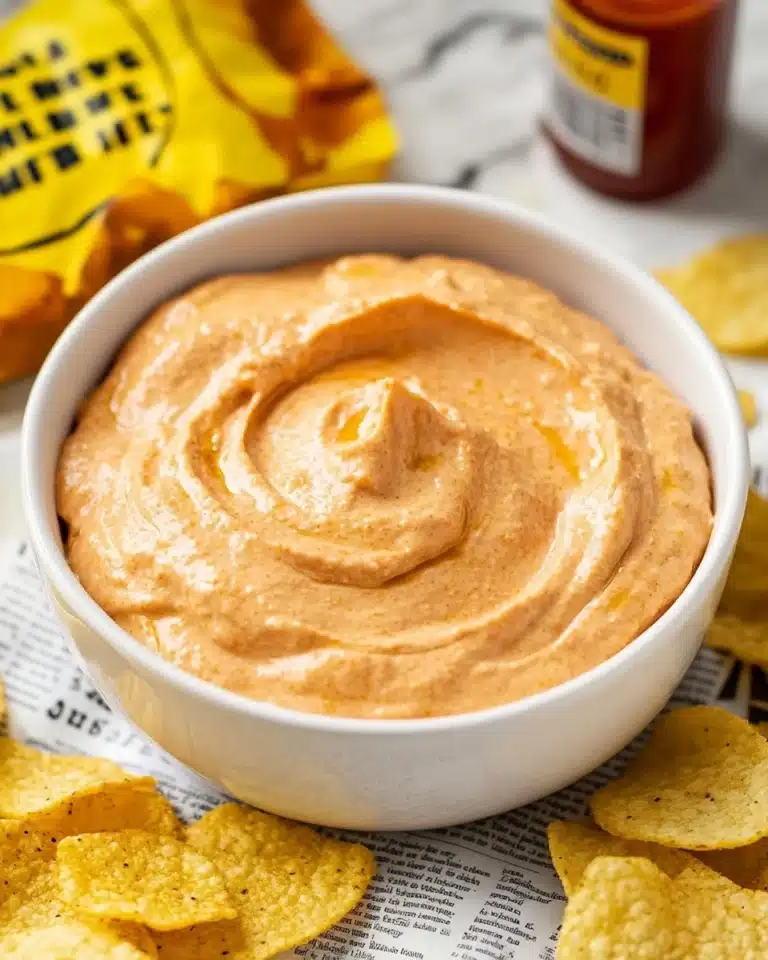If you’re craving something savory, comforting, and incredibly easy to whip up, this Gyudon Japanese Beef Bowls Recipe is going to be your new favorite. I absolutely love how this dish balances tender, thinly sliced beef with a lightly sweet, umami-packed sauce that seeps perfectly into fluffy Japanese rice. It’s such a quick dinner option on busy nights when you want something hearty without spending hours in the kitchen.
When I first tried making gyudon at home, I was amazed at how few ingredients you needed and how authentically it turned out. You’ll find that this Gyudon Japanese Beef Bowls Recipe is versatile too—it’s perfect anytime you want a satisfying meal that feels cozy yet fresh. Plus, it’s great for impressing guests without stressing out!
Why You’ll Love This Recipe
- Speedy & Simple: This recipe comes together in just about 15 minutes—perfect for weeknight dinners or quick lunches.
- Authentic Flavor: Using traditional Japanese staples like dashi, mirin, and sake brings out the classic gyudon taste you’ll find in Tokyo’s favorite eateries.
- Comfort in a Bowl: Tender beef with a slightly sweet savory sauce over warm rice makes it a crowd-pleaser every time.
- Easy to Customize: You can tweak toppings or swap ingredients to fit your pantry or preferences without losing the essence of gyudon.
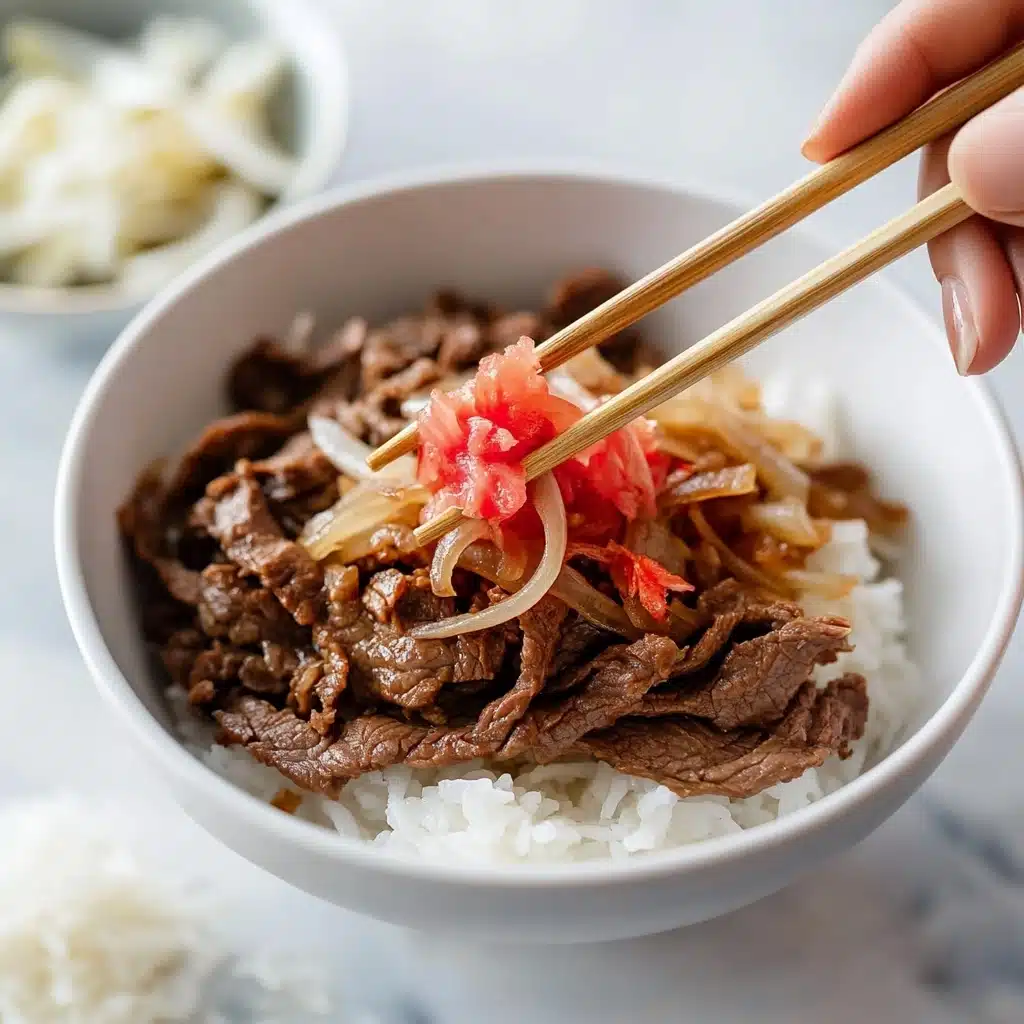
Ingredients You’ll Need
The magic of this Gyudon Japanese Beef Bowls Recipe really comes down to simple, high-quality ingredients that complement each other. Getting thinly sliced beef and authentic Japanese seasonings will help you nail that rich, comforting flavor.
- Thinly sliced beef: Choose well-marbled beef for tenderness; if possible, visit an Asian market for authentic gyudon-style sliced beef.
- Onion: Yellow or sweet onions add great sweetness when caramelized lightly with the beef.
- Red pickled ginger: This topping brightens the dish with sharp, tangy notes balancing the savory beef.
- Scallions: Thinly sliced for freshness and a mild onion flavor as garnish.
- Japanese rice: Short-grain rice is perfect here—it’s sticky and soft, holding up well under the rich sauce.
- Olive oil: Use a mild olive oil to gently sauté the onions without overpowering the flavors.
- Dashi powder: This instant powder packs in the deep umami foundation for the sauce.
- Sugar: Balances salty and savory notes with just a little sweetness.
- Sake: Adds depth and subtle sweetness; a cooking sake works well.
- Mirin: A sweet Japanese rice wine that enhances the glaze and aroma.
- Ginger juice: Adds warmth and a hint of zing that lifts the dish nicely.
- Soy sauce: The salty backbone of the sauce, so go for a good quality Japanese soy sauce if you can.
Variations
I love how forgiving this Gyudon Japanese Beef Bowls Recipe is, so I often switch things up depending on what my family is craving or what’s in the fridge. Feel free to add your own flair and make it your own!
- Vegetable Boost: I sometimes toss in mushrooms or thinly sliced carrots to add texture and color—both work wonderfully simmered in the sauce.
- Spicy Kick: Adding a splash of chili oil or a sprinkle of shichimi togarashi brings a lovely heat that wakes up the flavors.
- Beef Alternatives: When I’m out of beef, thinly sliced pork or even chicken thigh can be a great substitute, keeping cooking times similar.
- Vegan Version: Swap beef for seasoned tofu or mushrooms, and use vegetarian dashi powder to replicate the umami.
How to Make Gyudon Japanese Beef Bowls Recipe
Step 1: Prepare the Onion and Sauce
First, slice your onion into thin wedges—this helps them soften quickly and blend beautifully into the sauce. Heat the olive oil over medium heat in a saucepan, then add the onion. Cook until it turns translucent and just starts to soften; this usually takes about 3 to 4 minutes. You’ll want to stir occasionally to avoid burning but get some gentle caramelization for depth of flavor.
Step 2: Mix and Simmer the Sauce
Once your onions are ready, add the sauce ingredients: water, dashi powder, sugar, sake, mirin, ginger juice, and soy sauce. Give it a good stir to dissolve the dashi and sugar. Bring the mixture to a gentle simmer on medium heat. This creates that classic savory-sweet base that will soak into the beef.
Step 3: Cook the Thinly Sliced Beef
After the sauce starts simmering, add the thinly sliced beef. I like to spread the slices out evenly, letting them cook gently in the simmering sauce for about 5 minutes. This step requires just a watchful eye—avoid overcooking so the beef stays tender and juicy. Stir once or twice to make sure each piece soaks up the flavors.
Step 4: Serve and Garnish
Once the beef is cooked and the sauce has slightly reduced, remove the pan from heat. Spoon the mixture over warm bowls of cooked Japanese rice. Top with thinly sliced scallions and a small spoonful of red pickled ginger. These toppings add a pop of freshness and tang that brightens the rich beef beautifully.
Pro Tips for Making Gyudon Japanese Beef Bowls Recipe
- Use Thinly Sliced Beef: Getting the thinnest cut possible lets the beef cook quickly and absorb the sauce perfectly—don’t skip this to keep the texture tender.
- Simmer, Don’t Boil: Keep the sauce at a gentle simmer to concentrate flavors without toughening the beef.
- Fresh Ginger Juice: I discovered this trick when I started adding fresh ginger juice—it gives a lively brightness that bottled options can’t replicate.
- Don’t Overcook the Onions: Cook them until just translucent to keep their sweet crunch and avoid a mushy base.
How to Serve Gyudon Japanese Beef Bowls Recipe
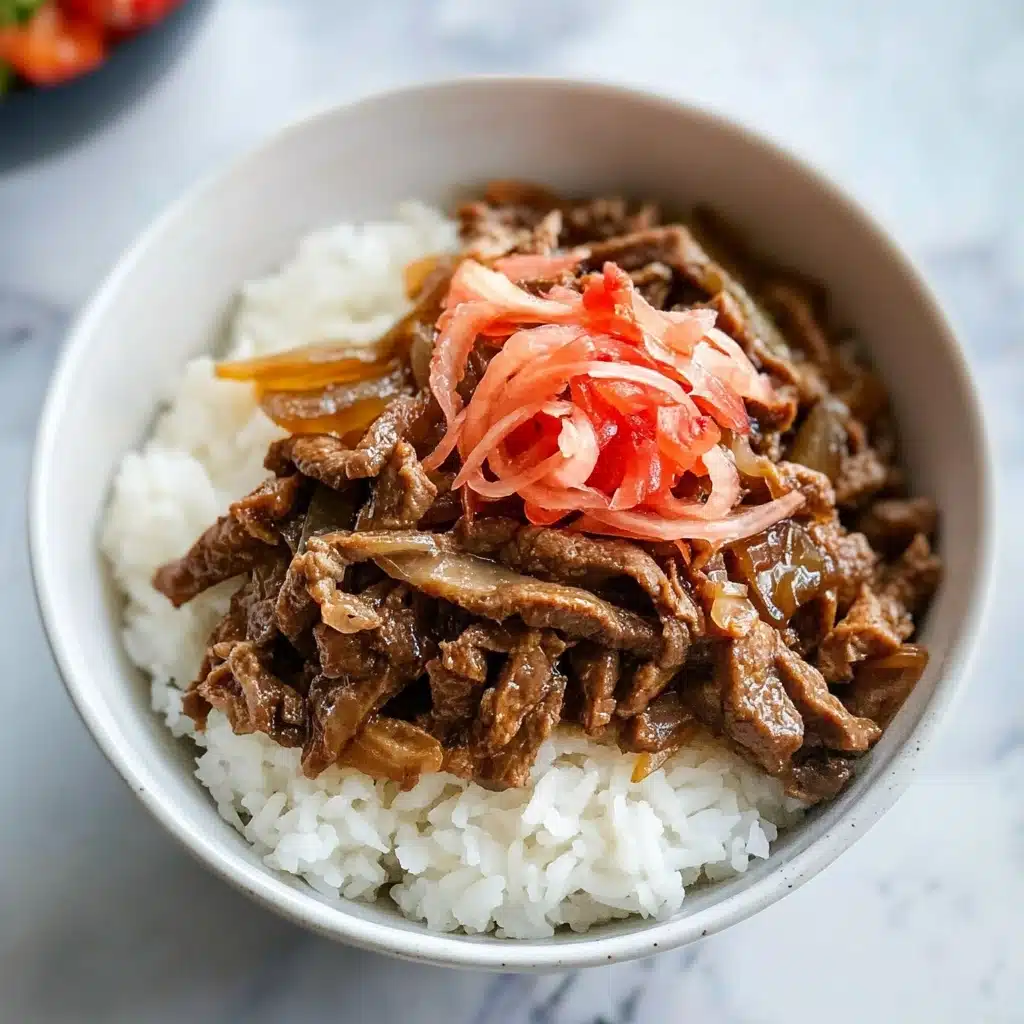
Garnishes
I always top my gyudon with a handful of thinly sliced scallions—they add a fresh crunch and aroma that contrast beautifully with the rich beef. The red pickled ginger is a must for me; it brings a sharp tang and vibrant color that brightens up every bite. Sometimes I like to add a raw or soft-boiled egg on top for extra richness.
Side Dishes
My go-to sides include a simple miso soup and steamed or pickled vegetables like cucumbers or daikon radishes. I find these light sides balance the savory depth of the gyudon without overwhelming it. If you want to add some greens, sautéed spinach or a basic seaweed salad works beautifully.
Creative Ways to Present
For special dinners, I’ve served gyudon in beautifully lacquered bowls and used a soft poached egg with a sprinkle of toasted sesame seeds to elevate things nicely. Another fun way is to build mini gyudon rice bowls as a DIY party platter, letting guests add their own garnishes and pickles for a casual vibe.
Make Ahead and Storage
Storing Leftovers
I usually store leftover beef and sauce in an airtight container in the fridge for up to 2 days. I recommend keeping the rice separate to avoid it getting soggy. Just reheat both separately for best texture.
Freezing
If I want to freeze this Gyudon Japanese Beef Bowls Recipe, I freeze the cooked beef and sauce in portioned containers without rice. The sauce freezes well and defrosts quickly in the fridge overnight. I usually don’t freeze the rice since it changes texture, but you could if you’re in a pinch.
Reheating
When reheating leftovers, I warm the beef gently on the stove with a splash of water or sake to loosen the sauce, stirring occasionally. The rice heats best in the microwave with a damp paper towel on top to keep it moist and fluffy.
FAQs
-
What cut of beef is best for making gyudon?
The best cut is thinly sliced ribeye or sirloin with good marbling, as it stays tender and flavorful when simmered. If you can’t find pre-sliced beef, ask your butcher to slice it very thinly or briefly freeze the beef to make slicing easier.
-
Can I use regular beef instead of thinly sliced?
Using thicker beef slices can make the dish less tender and increase cooking time. If you only have thicker cuts, slice them as thinly as possible or pound them thin before cooking to mimic the texture of traditional gyudon beef.
-
What can I substitute if I don’t have dashi powder?
If you don’t have dashi powder, you can use a mild chicken or vegetable broth, but it won’t have the same umami depth. For a closer flavor, try adding a small piece of kombu (kelp) while simmering and remove before serving.
-
Is gyudon healthy?
Gyudon can be a balanced meal with protein, carbohydrates, and moderate fat. Using lean beef or incorporating vegetables can make it lighter. Portion control with rice and toppings also helps keep it nutritious.
-
Can I make gyudon vegetarian or vegan?
Yes! Replace beef with mushrooms, tofu, or seitan and use vegetarian dashi or miso for the broth. Adjust seasonings to keep the rich umami flavor that makes gyudon so comforting.
Final Thoughts
I really hope you give this Gyudon Japanese Beef Bowls Recipe a try soon—it’s a dish that’s simple yet feels like a warm hug on a plate. I still remember how excited my family was the first time I made this for them, and now it’s a go-to whenever I want comfort food without fuss. Once you get the hang of the sauce, you’ll find yourself coming back to this recipe again and again. Trust me, once you have those tender beef bowls in front of you, you’ll be smiling with every bite.
Print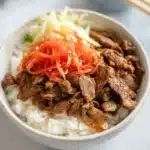
Gyudon Japanese Beef Bowls Recipe
- Prep Time: 5 minutes
- Cook Time: 10 minutes
- Total Time: 15 minutes
- Yield: 2 bowls 1x
- Category: Main Dish
- Method: Stovetop
- Cuisine: Japanese
Description
Gyudon, or Japanese Beef Bowl, is a comforting and flavorful dish featuring thinly sliced beef and onions simmered in a savory sauce made with dashi, soy sauce, and mirin, served over steamed Japanese rice and garnished with scallions and pickled ginger. This quick and easy recipe is perfect for a satisfying weekday meal.
Ingredients
Main Ingredients
- 150 g thinly sliced beef
- 1/2 onion, sliced into wedges
- 1 tbsp red pickled ginger (for topping)
- 1 tbsp scallion, diagonally and thinly sliced (for topping)
- 3 cups cooked Japanese rice
- 1/2 tbsp olive oil
Sauce Ingredients
- 200 ml water
- 1 tsp dashi powder
- 2 tsp sugar
- 1 tbsp sake
- 1 tbsp mirin
- 1 tsp ginger juice
- 2 tbsp soy sauce
Instructions
- Prepare Onion: Slice the onion into wedges to ensure they cook evenly and retain some texture.
- Cook Onion: Heat the olive oil in a saucepan over medium heat and cook the onion until it becomes translucent, about 3-4 minutes.
- Add Sauce Ingredients: Add water, dashi powder, sugar, sake, mirin, ginger juice, and soy sauce to the saucepan with the cooked onions. Stir to combine and bring the mixture to a simmer.
- Cook Beef: Add the thinly sliced beef to the simmering sauce. Cook over medium heat for about 5 minutes, stirring occasionally, until the beef is cooked through and the sauce has slightly reduced.
- Serve: Remove the saucepan from heat. Serve the beef and sauce over cooked Japanese rice bowls. Garnish each serving with sliced scallions and red pickled ginger for added flavor and color.
Notes
- You can substitute beef with thinly sliced pork or chicken if preferred.
- Adjust the sweetness of the sauce by modifying the sugar amount to taste.
- Use short-grain Japanese rice for authentic texture and flavor.
- Ginger juice can be replaced with grated fresh ginger if unavailable.
- Leftover beef can be stored in the refrigerator for up to 2 days and reheated gently.

